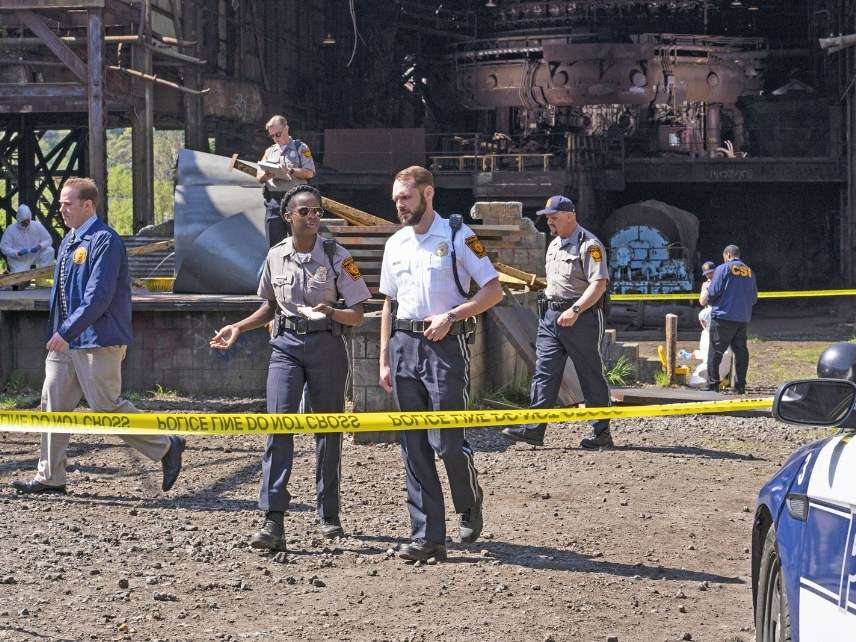Enjoy One Dollar's Murder Mystery; Ignore Its Awkward Class Struggle
CBS All Access show entertains, but its attempts at social relevance are dismal failures.

One Dollar. Available August 30 on CBS All Access.
One Dollar is a mystery. And I'm not talking about all those murders. Why anybody rolls out a new TV series in the dog days of August, right in the middle of the last summer frenzy of barbecues and pool parties, just weeks before television's attention turns en masse to the new fall schedule, is the most puzzling question since how Tim Robbins got that poster back up on the wall of his prison cell after crawling into the tunnel behind it to escape in The Shawshank Redemption. (A close second: How did a sentence as long as the last one ever get into print? You're not gonna get an answer to that, either.)
Regardless of cosmological objections, One Dollar is here, walking among us. ("Us" being the 4 million or so subscribers to CBS All Access, the network's pay service.) It's a murder mystery with a lot of plot turns, some of which head directly off cliffs. And its sociological ambitions about probing race and class go largely unfulfilled.
But as end-of-summer video junk food, you could do a lot worse. One Dollar's cast of scruffy characters is an interesting bunch, even when under lethal assault by their own writers. I wound up watching them for four hours, about three more than I planned, and each one was more enjoyable than the last.
The first thing to do while watching One Dollar is to completely discard the gimmick of the show's title—a single dollar bill, readily distinguishable by a few words and numbers handwritten on it in bright purple ink, that circulates unnoticed among the show's characters. Unless it's some kind of cryptic come-on to Fed fanboy nerds, the dollar bill means nothing; it doesn't move the plot at all.
The plot moves along just fine by itself. One Dollar is set in a battered Pennsylvania town where the only economic engine, the steel mill, is only precariously clinging to life. And when the workers arrive one morning to discover the mill floor flooded with blood, its days seem numbered in single digits.
Yet the investigation lacks any clear direction. Though the cops' forensic unit says the pool contains blood types from seven different victims, there are no bodies, and nobody has been reported missing.
But if the town is short on corpses, it positively brims with suspects. First among equals is Garret (Philip Ettinger, Indignation), once a bad-boy punk, now a single dad barely eking out a living at the steel mill, who was seen slinking through the woods that night.
But there's also Charles (Jeff Perry, Scandal), an aging grifter whose creeping entry into the first wisps of Alzheimer's is punctuated with indecipherable rages. And Ken (country rocker Sturgill Simpson, turning in a resourceful and amusing performance in his first time on screen), a one-time mill worker now scraping by with a flea market supplied by nightly burglaries.
And there are almost as many investigators as suspects. Police chief Peter Trask (Christopher Denham, Billions) seems capable, but has curious blind spots. Jake Noveer (Nathaniel Martello-White, Showtime's Guerrilla), a private detective who left the police department under a cloud, is suspiciously watching the cops while under a secret retainer from a wealthy developer whose motives are unknown but certainly sinister.
The most active sleuth of all may be the developer's just-out-of-high-school daughter Dannie (Kirrilee Berget, Amazon's Just Add Magic), who, during a secret tryst with one of her dad's employees, saw Garret in the woods on the night of the murders. Awash in hormones and certainly such a nice-looking young fellow couldn't be a mass murderer, Dannie goes undercover as Garret's babysitter to see what she can find out.
All this is taking place in an overgrown thicket of subplots, counterplots and general bad citizenship, including divorce, adultery, fraud, theft, and unspecified business blackguardery, much of it committed by characters I haven't even mentioned because they seem minor—but, boy, could I be wrong. With a set of characters the size of Dr. Zhivago and the skullduggery of a Trump cabinet meeting, One Dollar moves fast and furious.
And it's mostly sure-footed, plotted with the precision of an Agatha Christie novel and moving at a speed that doesn't leave a lot of room for contemplation. But once in a while, One Dollar's reveals turn into what-the-hell moments—they just don't fit with what you've already learned of the characters, as if Rosebud turned out not to be a sled but a Waring blender.
Those bloopers are jarring but occasional. One Dollar's attempts to turn a pretty good murder mystery into an examination of American class structure, on the other hand, are abject and total failures, but utterly inconsequential to its entertainment value. The show is too glossy to support sociological melodrama and gets dangerously dumb when it tries to force the issue. I cannot believe even the most woke college kid in America would be so clueless as to interrupt his attempt to hit on a girl with an existential demand like "You know how the other half lives?" Or that she would retort: "Not really, but you can drive there from here." Beam me up, Uber.
Show Comments (8)